|
|
| About Agra |
|
| Agra is an old city and it is said that its name is derived from Agrabana; a forest that finds mention in the epic Mahabharata. In more recent times Agra came into prominence when Sikandra Lodi made it his capital city in 1504. The Lodi rule was to end very soon and Agra passed into the possession of the Mughals. |
|
| It was during the time of third emperor Akbar that Agra came into its own. He embarked on the construction of the massive Agra Fort in 1565.Though Akbar was diverted into building a new capital at Fatehpur Sikri not far away, Agra continued to retain its importance and Shah Jahan, Akbar’s grandson ornamented the city with that masterpiece of Mughal architecture – the Taj Mahal and built several other beautiful buildings within the Agra Fort. |
|
|
 Taj Mahal Taj Mahal |
|
Variously defined as ‘A Materialised Vision of Loveliness’; ‘A Poem in Stone’; ‘A Dream in Marble’; ‘A Noble Tribute to the grace of Indian Womanhood’. ‘A Resplendent Immortal Tear Drop on the Cheek of Time.’; ‘A Monument of Love and ‘A Wonder of the World’, the Taj Mahal is representative of the glorious Mughal age and is a unique gift of the medieval period to the people of India.
Emperor Shah Jahan built the Taj as a memorial to his beloved wife Mumtaz Mahal. The finest of skilled artisans were brought in to inlay the white marble edifice with precious stones and to conjure filigreed marble screens around the cenotaphs of the emperors and his beloved queen. There is a jewel–like quality about the Taj Mahal. The beautifully proportioned octagonal structure |
|
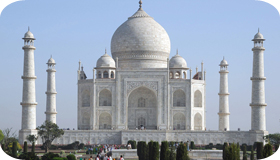 |
| topped by a perfect dome is balanced by 4 soaring minarets that stand at the corners of the plinth. |
|
| The Taj Mahal is ethereal at any part of the day – blushing in the rosy glow of dawn or sunset, appearing like a pearly mirage in the moonlight or reflected in the pools of the garden. |
|
|
 Agra Fort Agra Fort |
|
| The great Mughal Emperor Akbar commissioned the construction of the Agra Fort in 1565 A.D., although additions were made till the time of his grandson Shah Jahan. The forbidding exteriors of this fort hide inner paradise like the Moti Masjid, Diwan-i-am, Diwan-i-khaas, Musamman or Samman Burj, Jehangir’s Palace, and Khas Mahal & Shish Mahal. |
|
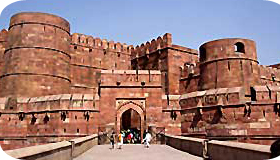 |
|
|
 Sikandra Sikandra |
|
About five miles from Agra City on Mathura Road lies the village of Sikandra. In 1492 A.D., Sikandra Lodi of Lodi Dynasty, after occupying Agra used this place as the capital of his Empire. He called it Sikandra. After 99 years of Sikandra Lodi’s Empire in 1602 A.D. Emperor Akbar fixed this place for his Mausoleum started to built it. The mausoleum proper stands on the marble plot from 496 feet square and 30 feet high from the level of the ground.
The mausoleum is a five-storeyed building. The base of mausoleum is 339 feet square. After the death of Akbar when Jahangir went to pay homage to his father on foot he was not satisfied with the construction of his father’s tomb. He extended the area and completed in 1613 A.D. |
|
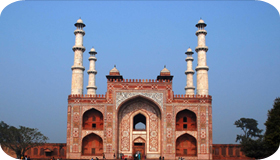 |
|
|
|
|
 Fatehpur Sikri Fatehpur Sikri |
|
Fatehpur Sikri, the City of Victory and enduring monument to the great Mughal Emperor Akbar lies 23 miles from Agra in a great plain unrelieved by a small hill. Up to the end of 14th century it was occupied by the Rajput chiefs. At the same spot a decisive battle was fought between Babar and famous warrior, Rana Sanga.
Formerly it was a small village called Sikri and was the home of Stone cutters.
Sheikh Salim Chishti celebrated Mohammedan saint dwelt here in a cave. He was very much famous for his spiritual deeds. In 1569 A.D. Akbar founded his city and then began to rise great battlemented walls, the magnificent palaces and courtyards. The great mosque and other superb specimens in red sandstones which stands to this day a source of wonder and administration to visitors. After Akbar’s death, Fatehpur Sikri was soon deserted with in 50 years of its founding mainly due to lack of water. |
|
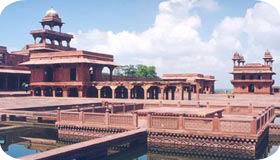 |
|
|
 I’timadud Daulah I’timadud Daulah |
|
The tomb of Mirza Ghiyas Beg, entitled I’timadud Daulah, is situated on the left bank of the Jamuna. It was constructed by his daughter Nur Jehan, the famous consort of Jehangir, between 1622 and 1628. Mirza Ghiyas was the son of Khwaja Muhammad Shariff who was the Vazir (Prime Minister) of Khurasan and then of yazd under the Safawid Emperors of Persia.
After the death of his father, Mirza Ghiyas came to India and was introduced to Akbar who enrolled him in the Imperial service. Mirza was an able man and rose high by the sheer dint of his merit. He held the title of I’timadud Daulah’ or the Lord Treasurer of the Mughal Empire, and died in 1622. |
|
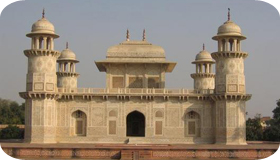 |
|
|
 Radhasoami Monuments Radhasoami Monuments |
|
| At about a distance of 4 miles from Agra City is the Samadhi of Radhasoami. Agra is also the seat of Radhasoami faith, which was established here, in 1861, by Soami Maharaj (1818-78) the foundation Guru, and Huzur Maharaj (1829-98), his chief disciple and successor. Based on such sublime principles as Guru Bhakti (total faith in grace of the Guru or preceptor) and Suratshabdyoga (realization of the supreme being through inner meditation), in true tradition of the Bhakti (devotional worship, as a mean of moksa or emancipation), it is essentially a santmat or saintly viewpoint, way, or philosophy of life, which is simple and practical. It prescribes no rituals or externalia, and it follows no distinction of caste or ‘varna’, and it belongs, heart and soul, to that vigorous intellectual and creative activity which marked the 19th century Indian Renaissance. |
|
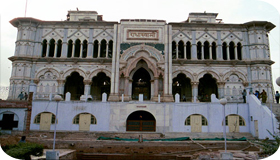 |
|
|
 Jama Maszid Jama Maszid |
|
| This Jama Maszid, a fine structure, stands in front of Agra Fort Station. The mosque was built by Emperor Shah Jahan according to the choice of his favorite daughter Jahan Ara Begum in 1644 A.D. and was completed in 1649 A.D. The mosque has three gateways but the main gate is towards the north, Jama Maszid is 380 feet by 270 feet and is on a platform of 11 ft. building consists of three compartments, each surmounted by dome built of white and red sand stone in a zigzag way. There are octagonal doomed cupolas on its each corner and small cupolas on its four sides. It is a wonderful assimilation of Iranian architecture. |
|
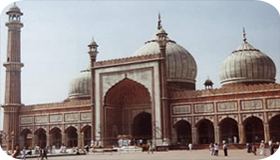 |
|
|
|
|
|